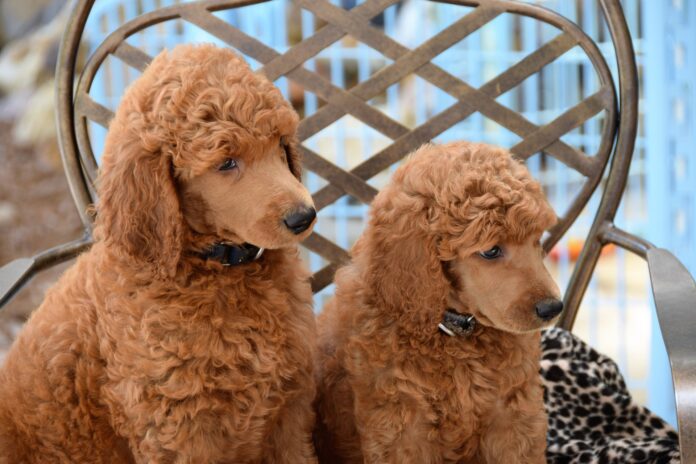The Portuguese Water Dog wavy coat dog and he is a medium-sized, muscular dog with a wide, domed head, a black nose, and round, dark eyes. The tail, which is not docked for swimming, is tapering. The legs are straight and the feet are webbed. The coat of the Portuguese Water Dog is either wavy or straight. Their coat can be curly, straight, or even curly-wavy.
Portuguese Water Dog Wavy coat – Curly-haired Portuguese water dogs have variant forms of FGF5 and RSPO2
Three dog breeds have variant forms of FGF5 and / or RSPO2 genes: the short-haired Irish water spaniel, the wire-haired Poodle, and the curly-haired Portuguese water dog. These dogs have the insertion in RSPO2 on one or both alleles, and they have long, curly coats.
Previously, it was thought that the FGF5 gene was responsible for hair length in dogs. This gene was isolated by fine-mapping. A Cys-to-Phe change in residue 95 was associated with long haired dogs. Interestingly, only 3.9% of short-haired dogs and 30.2% of medium-haired dogs carried the FGF5 allele. The researchers then identified a new gene, KRT71, as a potential curly-haired gene, which is an Arg-to-Trp change. In mice, this gene is linked to curly-haired coats.
The findings have implications for health and breeding in Portuguese water dogs. Genetics of a dog breed can help us find the genes responsible for complex traits, such as ear tufting and body fat, and improve treatments for those with the underlying condition. The study authors note that their research shows that the two variants of FGF5 and RSPO2 are related.
Portuguese water dogs have cataracts and progressive retinal atrophy
Although there are no known symptoms of cataracts in Portuguese water dogs, they are more susceptible to the eye conditions known as progressive retinal atrophy and lymphosarcoma. Although not painful, these conditions can lead to blindness in your pet. Early symptoms of these diseases include dilated pupils and night blindness. The PWDCA recommends that you bring your pup to an opthamologist for an eye examination at eight weeks of age.
A large number of breeds of dogs are susceptible to progressive retinal atrophy (PRA), a genetic disease that affects the retina. It causes widespread degeneration of photoreceptor cells, which can ultimately result in blindness. This condition is hereditary, but it is not rare. The disease is inherited in some dogs, affecting over 100 different breeds. Each breed may develop the condition at different ages. The rate at which the condition progresses and the number of affected males and females vary according to breed.
They are a high-energy breed
The Portuguese Water Dog’s wavy coat is not only attractive, but it also requires regular brushing to maintain a beautiful look. A typical coat clipping schedule is six to eight weeks. Clipping the coat of the Portuguese Water Dog should be done to maintain a mat-free coat and to remove shed hair. Portuguese Water Dogs have an average life span, and their high energy level can make them high-risk dogs for people with allergies.
Because The high energy level of this breed makes it an ideal choice for families with children. This breed is highly alert and will generally greet visitors with open arms. Its spring-loaded legs make for an extremely energetic dog. This breed should receive plenty of exercise, including jogging, hiking, and play fetch. If you cannot provide enough exercise for your dog, he may turn destructive. A high-energy dog like the Portuguese Water Dog will chew toys and will need exercise to remain happy and healthy.
Portuguese Water Dog Wavy coat – They need daily physical and mental exercise
A daily walk, jog, or swim is essential for your new pup. Because Portuguese water dogs are generally healthy and need daily physical and mental exercise to maintain their beautiful wavy coat. Although their coat is hypoallergenic and low-shedding, their water-loving nature can pose problems for those with allergies. As with any dog breed, Portuguese water dogs require daily physical and mental exercise and daily physical interaction.
In addition to exercise, the Portuguese Water Dog requires physical and mental stimulation. These dogs do well in dog agility and therapy work and are fast becoming popular in hospitals. Fortunately, their hypoallergenic, non-shedding coats make them great candidates for dog sports. Keeping them active daily can be challenging, but they do have a tendency to chew on household items when bored. Physical and mental exercise is essential for preventing a Portuguese water dog from chewing up your favorite furniture, shoes, or clothing.





